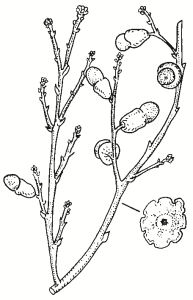Family:
Santalaceae
Exocarpos cupressiformis
Native Cherry
Other Names: Cherry Ballart, Wild Cherry
First Nations Name(s): Palatt, Ballot

Name Origin:
Exocarpos — from Greek exo, outside, plus carpos, fruit, as the succulent pedicel or flower stalk resembles the pericarp or fruit wall below the nut.
cupressiformis — meaning cypress-form, referring to resemblance to Cypress species.
Regional Subspecies:
Similar Species:
Distinguish from other Cherry in region, Dwarf Cherry (Exocarpos strictus) mainly by its greater size.
Occurrence:
Regional:
Widespread across entire region.
Australia:
Qld, NSW, Vic, Tas, SA.
Habitat:
Various habitats and soils, including open forest and woodland.
Habit:
Shrub or small tree to 8 m high. Dense yellowish-green or bronzy foliage.
Site Preference:
Poor shallow soils.
Characteristics:
Parasitises roots of surrounding plants when young.
Flowering:
Cream, mainly Oct-May, and throughout year. Inconspicuous.
Seed Collection:
Early Oct to late Mar. Monitor closely as seeds released 3-14 days after maturity.
Propagation:
Difficult. From seed or cuttings. Untreated seed may take 6-18 months to germinate. Bird- ingested seed (passed through hens) extracted and sown into pots with host plants such as Kangaroo Grass (Themeda triandra) has germinated. Thought that seedlings should be planted out within 12 months of germination near plants of families: Casuarinaceae, Fabaceae, Mimosaceae, Myrtaceae or Proteaceae. For cuttings, jam a sharp spade into soil at intervals around trees. Damaged roots will sucker. Transplant root suckers.
Regeneration:
Suckers vigorously from damaged roots.
VALUES:
Shade & Shelter:
Useful low-level cover in windbreaks. Plant on leeward side as plants are brittle (although coppice readily). Foliage reputedly poisonous to livestock, although grazed by kangaroos and wallabies.
Land Protection:
Timber pinkish, soft, close-grained and light when dry. Excellent for turning. Was used for tool handles, wheel spokes and gun stocks.
Wildlife:
Excellent habitat. Fruit are a food for native birds including Silvereyes, Mistletoebirds, Satin Bowerbirds, Grey Butcherbirds, honeyeaters, currawongs and parrots, many of which disperse seed. Many birds, including the Turquoise Parrot, shelter in dense foliage.
First Nations:
Juicy part of fruit (stalk) eaten. Spearthrowers and ‘bullroarers’ made from wood. Snake bite reputedly treated with sap.
Ornamental:
Excellent ornamental due to attractive fine foliage. Prune or coppice old plants to rejuvenate.
